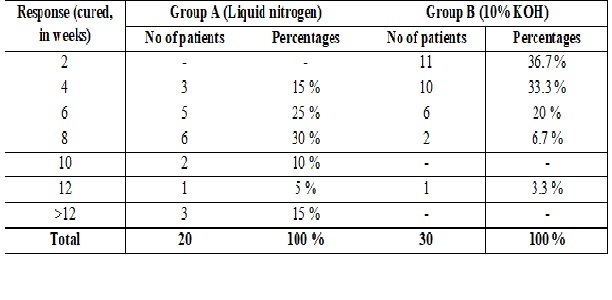Comparison of cryotherapy with liquid nitrogen and 10% KOH in the management of molluscum contagiosum in pediatric patients
Abstract
Introduction: Molluscum contagiosum (MC) is as viral infection caused by a pox virus commonly affects the children. The lesions of MC are firm, small, papules <1mm size, often with an umbilicated center. MC in children mostly resolves spontaneously and the treatment does help to minimize autoinoculation and transmission to others.
Objectives: To study demographic profile and clinical presentation of MC in pediatric patients and to study the therapeutic efficacy and side effects of liquid nitrogen cryotherapy and 10% KOH in treatment of MC in pediatric patients.
Methods: A prospective observational study done at tertiary care hospital. Demographic details, detailed history of present and past similar illness, family history related to MC and its treatment was noted. Each patient was examined thoroughly and number, size, location of lesions were noted. All patients were divided in two groups group A (liquid nitrogen treated) & B (10% KOH treated). Results of the trial were entered in a Performa designed to facilitate the study of fate of all patients.
Results: School going and preschool children were the commonest age group involved with 34% in each group. M:F ratio was 1.6:1. Group A showed 70% cured rate in 8 weeks of therapy while Group B 70% got cured in 4 weeks and 90% cured in 6 week of therapy. Commonest side effect was burning pain seen in 65% of patients in group A, followed by hyperpigmentation (55%), erythema (15%), hypopigmentation (10%) and infection (5%). And in Group B common side effects were hypopigmentation (56.6%), followed by burning or stinging (20%), infection (16.7%), erythema (6.7%) and infection (3.3%).
Conclusion: 10% KOH gives faster results in 2-4 weeks of duration, while liquid nitrogen requires longer duration of treatment of 8 – 12 weeks. Also liquid nitrogen is more painful procedure, perhaps it is difficult to apply in crying children. On contrary 10% KOH is painless, with only mild stinging sensation in few patients. So, it is more feasible and has higher compliance among parents, whereas liquid nitrogen needs regular weekly visits.
Downloads
References
Arndt KA, Bower KE. Molluscum Contagiosum. Manual of dermatologic therapeutics with essential of diagnosis. 6th edition. Lippincott Williams & Wilkins 2002.p. 161-3.
Brooks GF, Butel JS, Morsesa. Pox viruses. Jawetz, Meluick, Adelberg’s Medical microbiology. 22nd edition. McGraw-Hill 2002. p. 391-402.
Niizeki K, Kano O, Kondo Y. An epidemic study of molluscum contagiosum. Relationship to swimming. Dermatologica. 1984;169(4):197-8.
Juliusberg M. Zu rKenntnis des virus des. Molluscum Contagiosum. Dtsch Med Wochenschr1905;31:1598-99.
Mahajan BB, Pall A, Gupta RR. Topical 20% KOH. An effective therapeutic modality for molluscum contagiosum in children. Indian J Dermatol VenereolLeprol2003;69:175-7.
Choong KY, Roberts LJ. Molluscum contagiosum, swimming and bathing: a clinical analysis. Australas J Dermatol. 1999 May;40(2):89-92.
Ormerod AD, White MI, Shah SA, et al. Molluscum contagiosum effectively treated with a topical acidified nitrite, nitric oxide liberating cream. Br J Dermatol. 1999 Dec;141(6):1051-3.
Silverberg NB, Sidbury R, Mancini AJ. Childhood molluscum contagiosum: experience with cantharidin therapy in 300 patients. J Am Acad Dermatol. 2000 Sep;43(3):503-7.
Savant SS, Metha N. Cryosurgery. Savant SS, Shah RA, Gore D. ASCAD Textbook and atlas of Dermatosurgery and Cosmetology 1st edi. ASCAD – Mumbai 2000;16:96-104.
Romiti R, Ribeiro AP, Romiti N. Evaluation of the effectiveness of 5% potassium hydroxide for the treatment of molluscum contagiosum. Pediatr Dermatol. 2000 Nov-Dec;17(6):495.
Hammes S, Greve B, Raulin C. [Molluscum contagiosum: treatment with pulsed dye laser]. Hautarzt. 2001 Jan;52(1):38-42.

Copyright (c) 2019 Author (s). Published by Siddharth Health Research and Social Welfare Society

This work is licensed under a Creative Commons Attribution 4.0 International License.


 OAI - Open Archives Initiative
OAI - Open Archives Initiative


